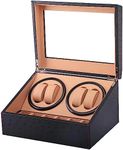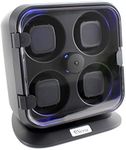Buying Guide for the Best Watch Winder Box
Choosing a watch winder box is all about making sure your automatic watches stay wound and ready to wear, while also keeping them safe and displayed nicely. The right winder will depend on how many watches you have, the types of watches you own, and where you plan to keep the box. It's important to think about both the practical features and the style that fits your space and collection.Number of Watch SlotsThe number of watch slots refers to how many watches the winder can hold and wind at the same time. This is important because you want to make sure all your automatic watches are kept running if you rotate between them. Winders can range from single-slot models for one watch to large boxes that hold a dozen or more. If you only have one or two automatic watches, a small winder is enough. If you have a growing collection, consider a larger box or one with extra storage for future watches.
Rotation SettingsRotation settings control how the winder moves your watches, including the direction (clockwise, counterclockwise, or both) and the number of turns per day (TPD). This is important because different watches have different winding needs, and using the wrong setting can either overwind or not wind your watch enough. Most winders offer adjustable settings. If you have watches from different brands, look for a winder with customizable rotation options so you can match each watch’s requirements.
Power SourceThe power source is how the winder gets its energy—usually either from an AC adapter (plugged into the wall) or batteries. This matters because it affects where you can place the winder and how portable it is. If you want to keep your winder in a fixed spot, an AC-powered model is fine. If you need flexibility or want to keep it in a safe or closet, a battery-powered or dual-power model is more convenient.
Noise LevelNoise level refers to how much sound the winder makes while operating. This is important if you plan to keep the winder in your bedroom or office, where a noisy motor could be distracting. Some winders are designed to be very quiet, while others may hum or click. If you’re sensitive to noise or want to use the winder in a quiet space, look for models that advertise silent or ultra-quiet motors.
Build Quality and MaterialsBuild quality and materials describe how sturdy and attractive the winder is, and what it’s made from—like wood, leather, plastic, or metal. This is important for both durability and appearance, especially if the winder will be on display. Higher-quality materials usually last longer and look better. If you want a winder that matches your room or furniture, pay attention to the finish and design. If you plan to move it often, a lighter or more durable material might be better.
Watch Cushion Size and FitThe watch cushion is the part that holds your watch in place inside the winder. The size and fit are important because a cushion that’s too big or too small can damage your watch or fail to hold it securely. Some winders offer adjustable or different-sized cushions to fit both large and small watches. If you have oversized or very small watches, make sure the winder can accommodate them comfortably.
Additional FeaturesAdditional features can include things like built-in storage for extra watches, display windows, interior lighting, or security locks. These extras aren’t necessary for everyone, but they can add convenience or style. If you want to show off your collection, a display window and lighting are nice. If you want to keep your watches safe, look for a lock. Think about which features will actually make your experience better, based on how and where you’ll use the winder.
















